Abstract
1. Three tetracarboxylate porphyrins, apart from coproporphyrin, were isolated from the faeces of patients with symptomatic cutaneous hepatic porphyria and of rats with porphyria caused by hexachlorobenzene poisoning. The porphyrins were not present in the urine of the porphyric rats or in the faeces of control rats. 2. Two of the porphyrins were identified as tris-(2-carboxyethyl)-carboxymethyl ethyl trimethyl porphin (isocoproporphyrin) and tris-(2-carboxyethyl)-carboxymethyl trimethyl porphin (de-ethyliso-coproporphyrin). 3. The third porphyrin, previously reported to be an analogue of coproporphyrin in which one propionate group is replaced by an α- or β-hydroxypropionate group, was shown to be tris-(2-carboxyethyl)-carboxymethyl-(1-hydroxyethyl)-trimethyl porphin (hydroxyisocoproporphyrin). 4. The order of β-substituents around the porphin ring could not be determined for any of the compounds. 5. Evidence for the existence of a fourth porphyrin, tris-(2-carboxyethyl)-carboxymethyl trimethyl vinyl porphin (dehydroisocoproporphyrin), a postulated precursor of the others, is described. 6. It is suggested that dehydroisocoproporphyrinogen is produced by decarboxylation–dehydrogenation of one of the propionate groups of pentacarboxylate porphyrinogen III.
Full text
PDF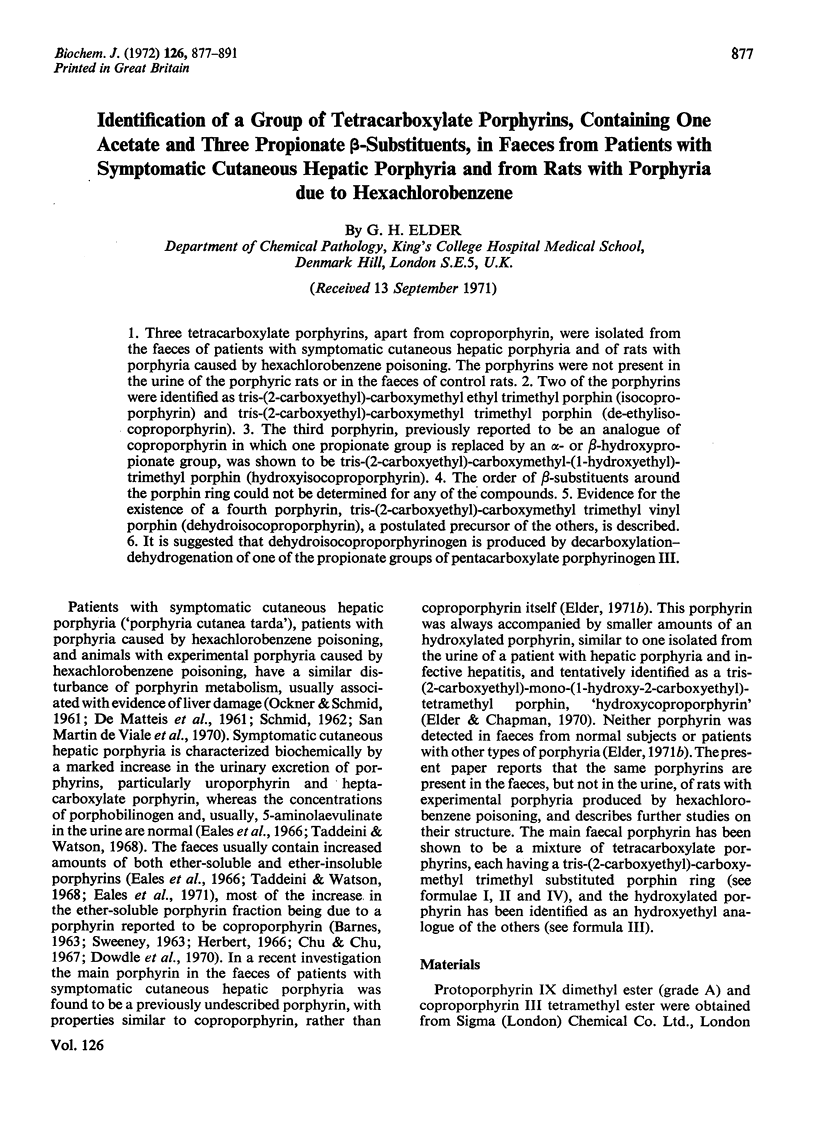
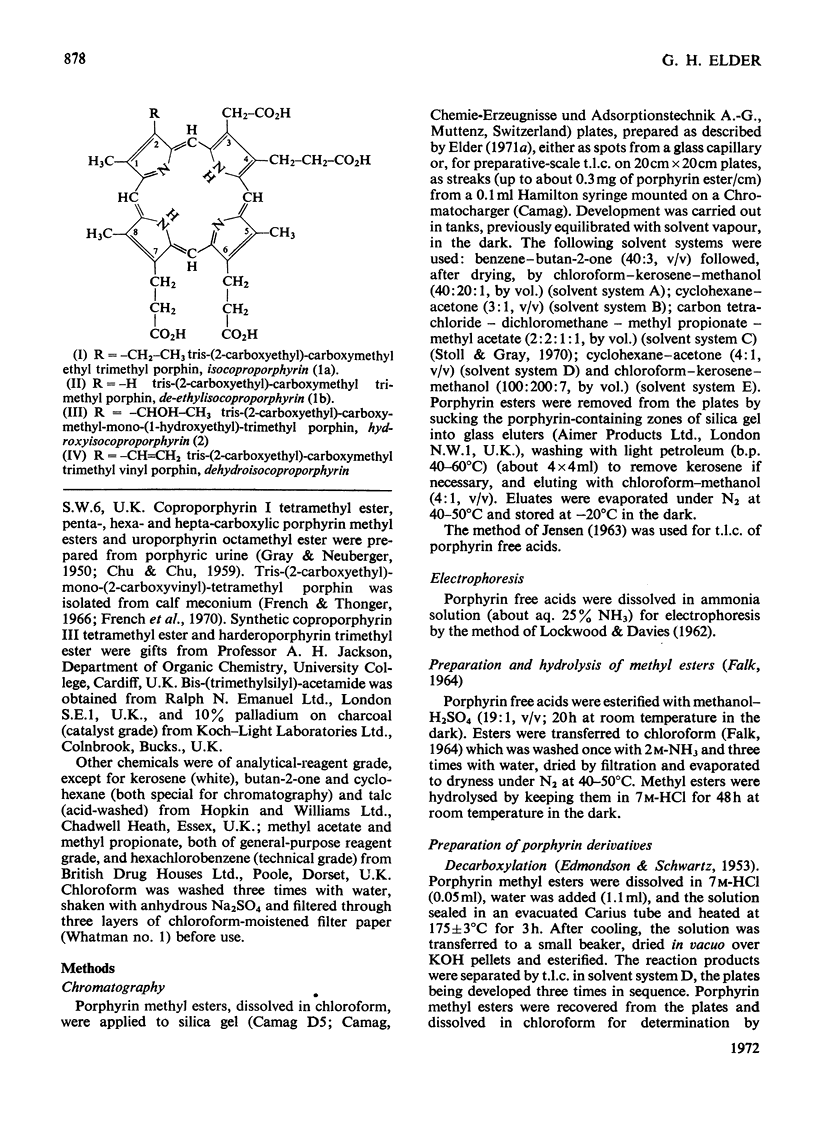
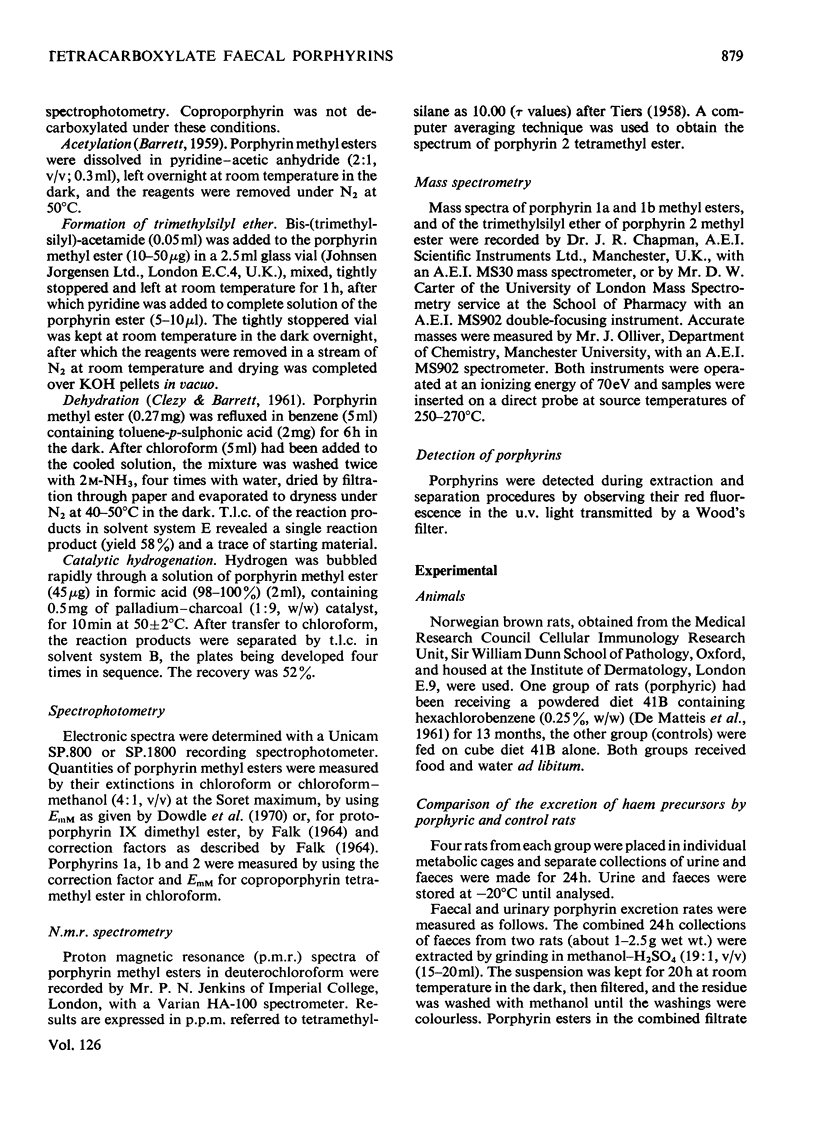
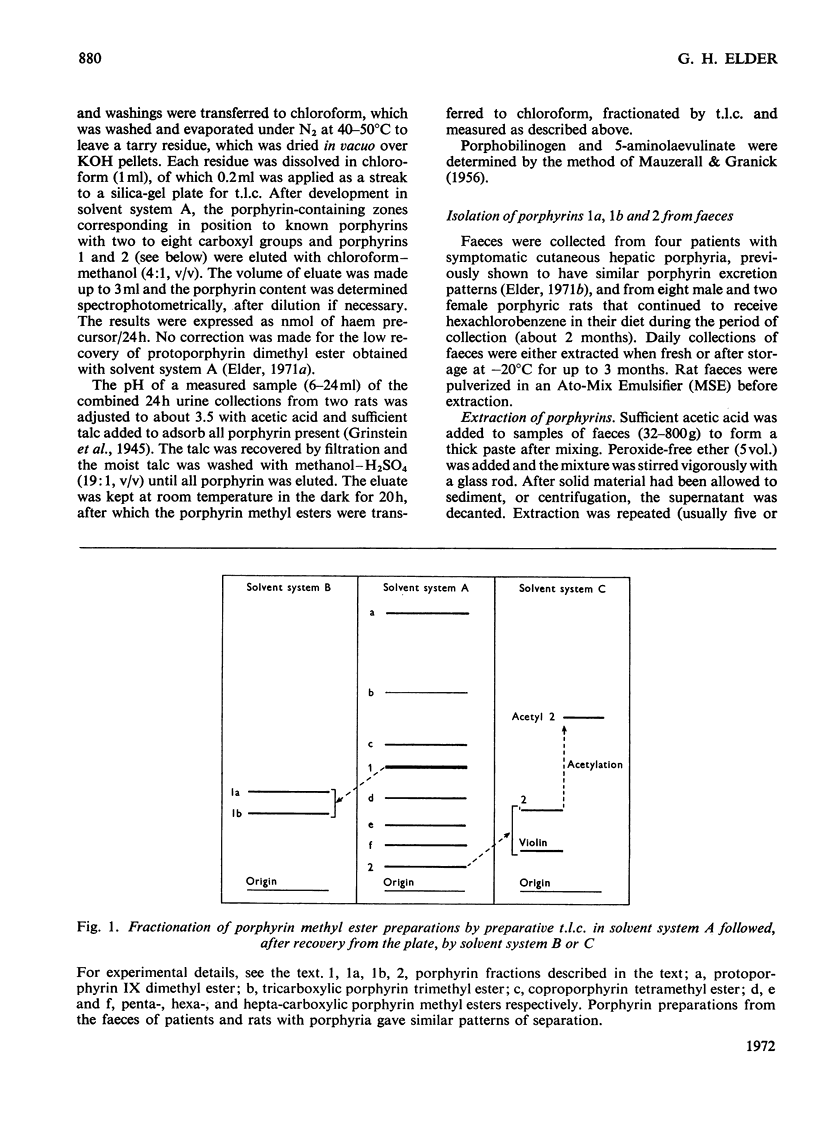
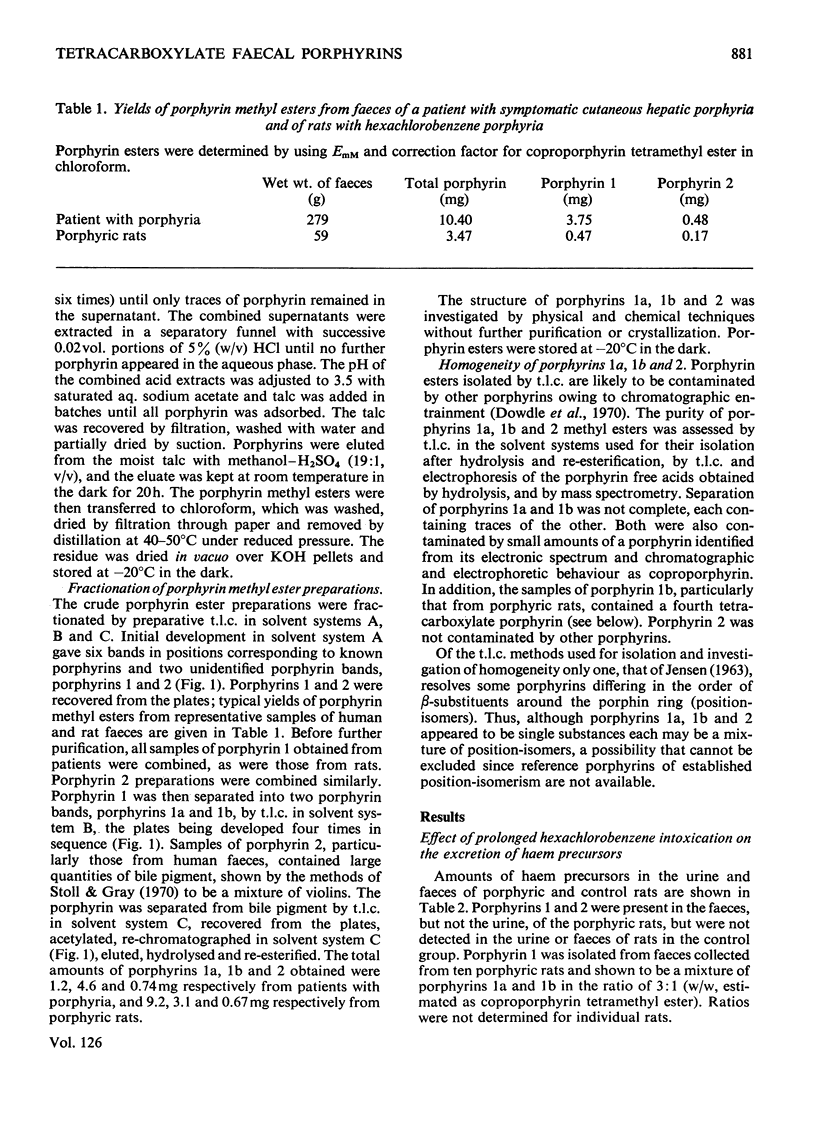

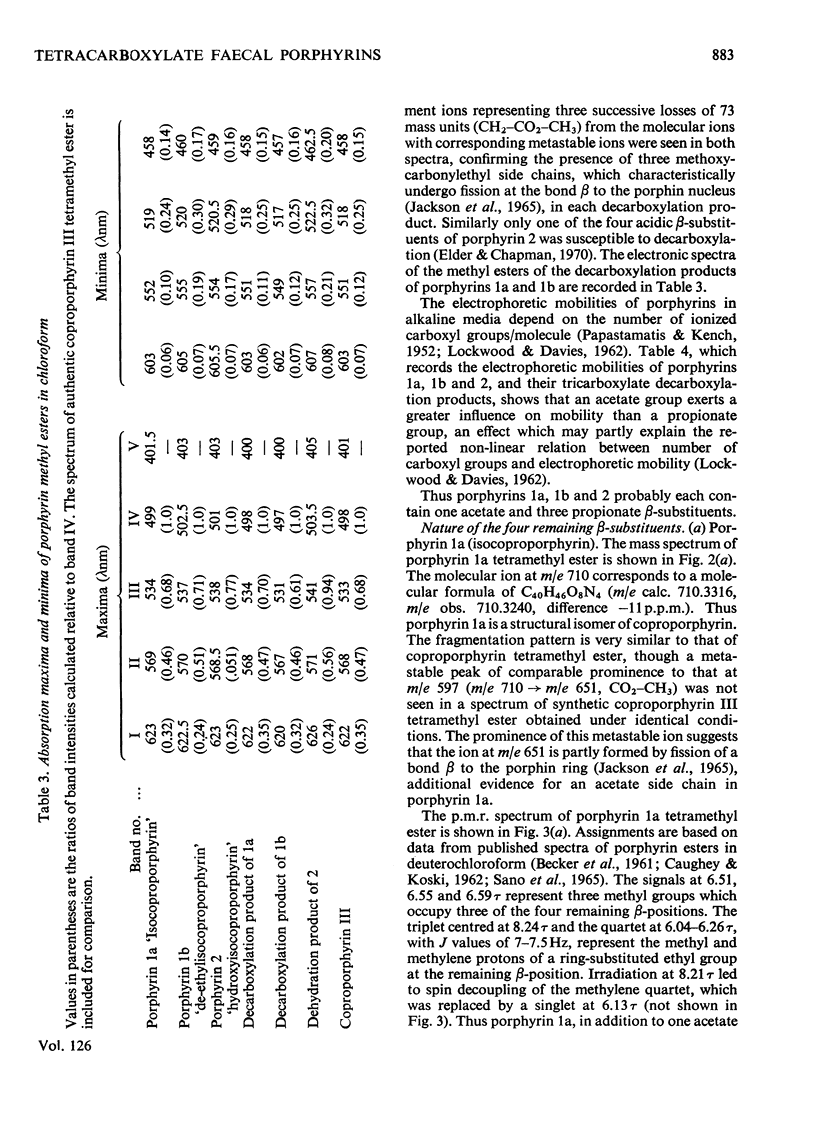
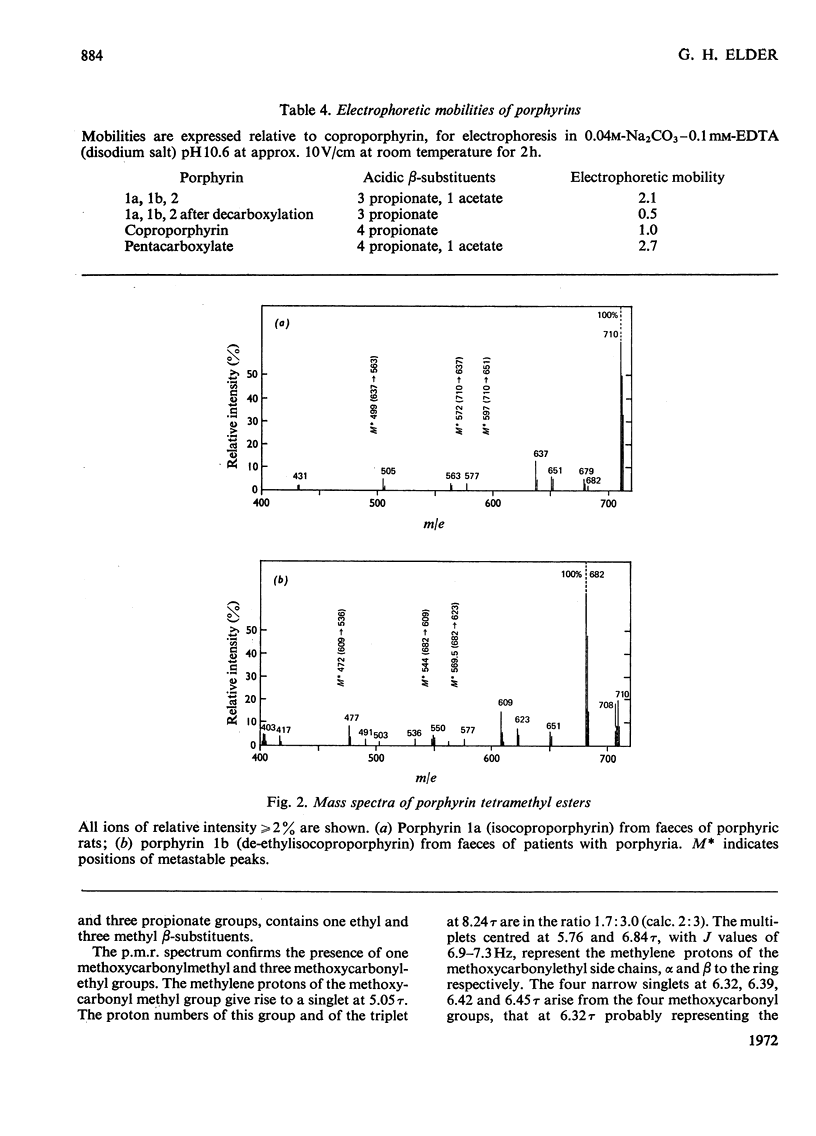
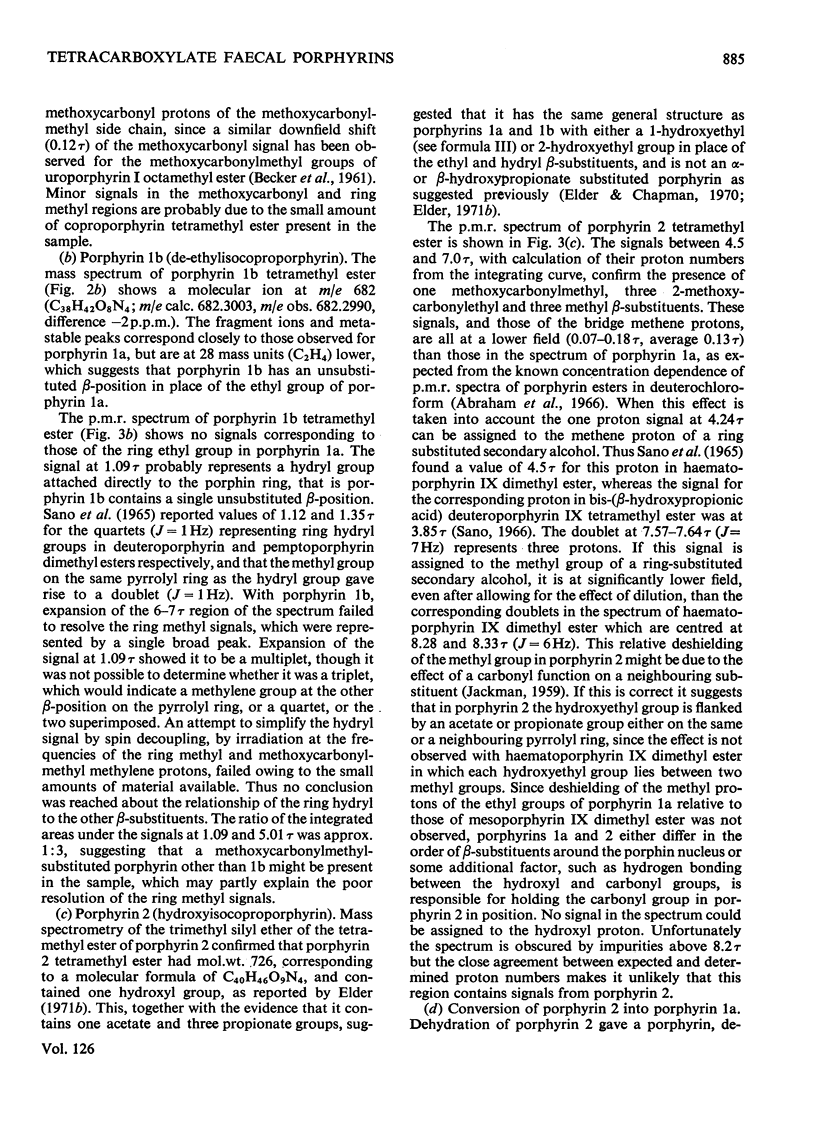

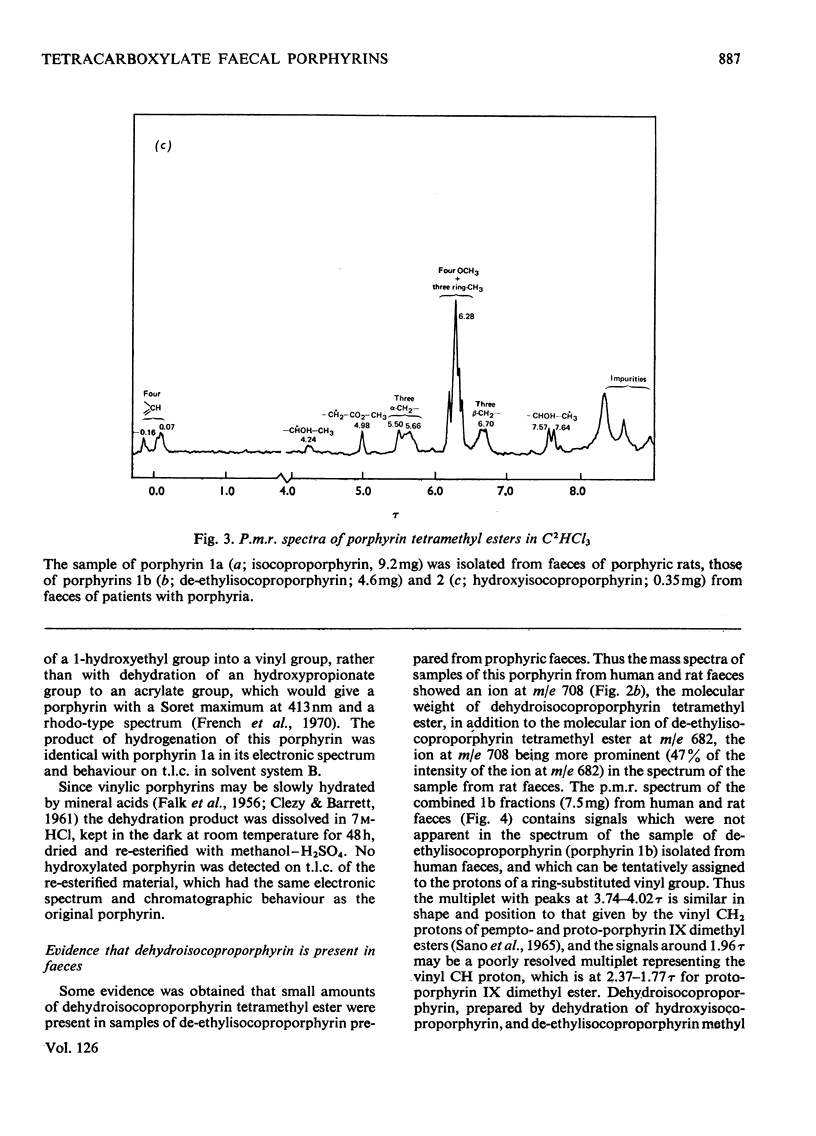
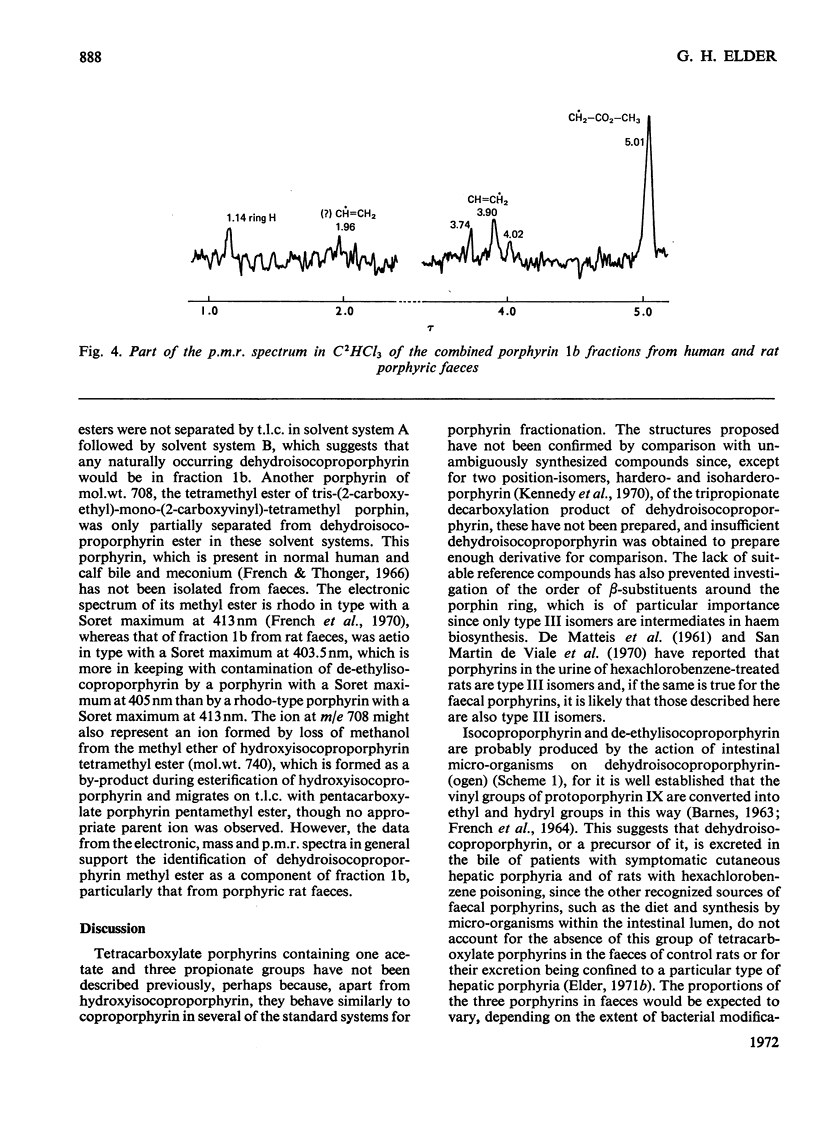
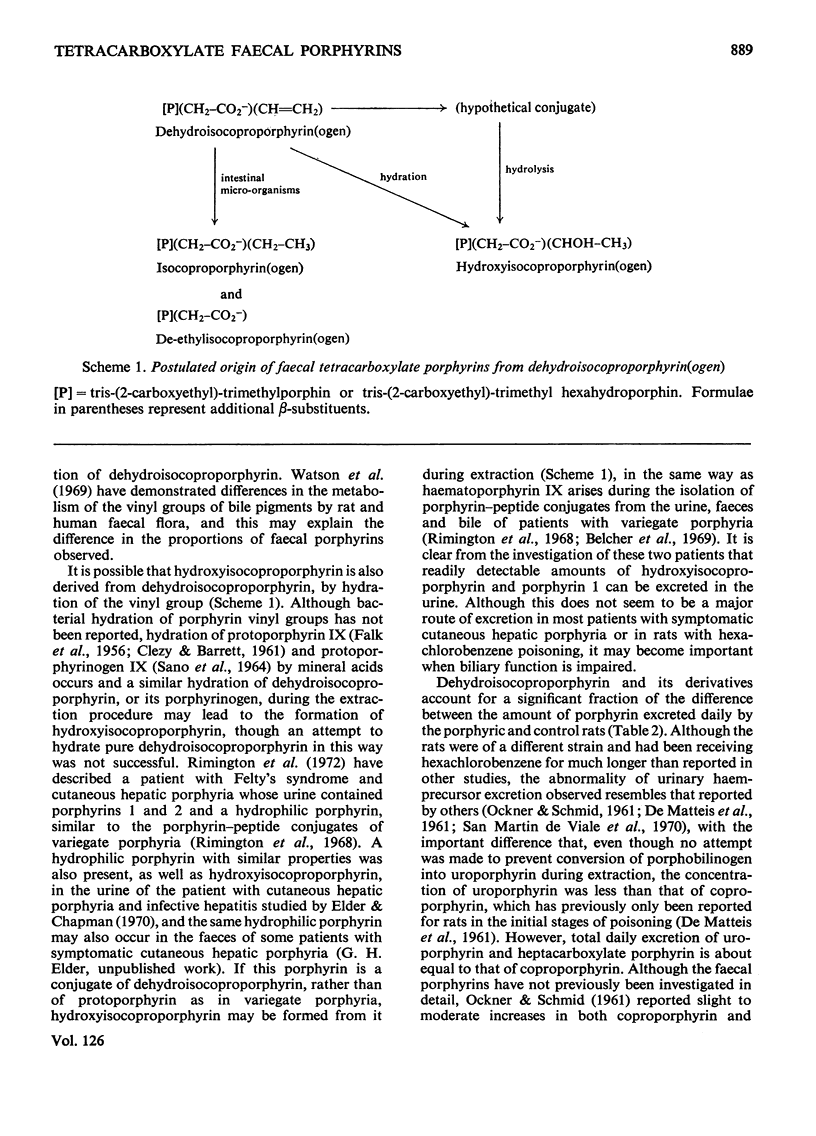
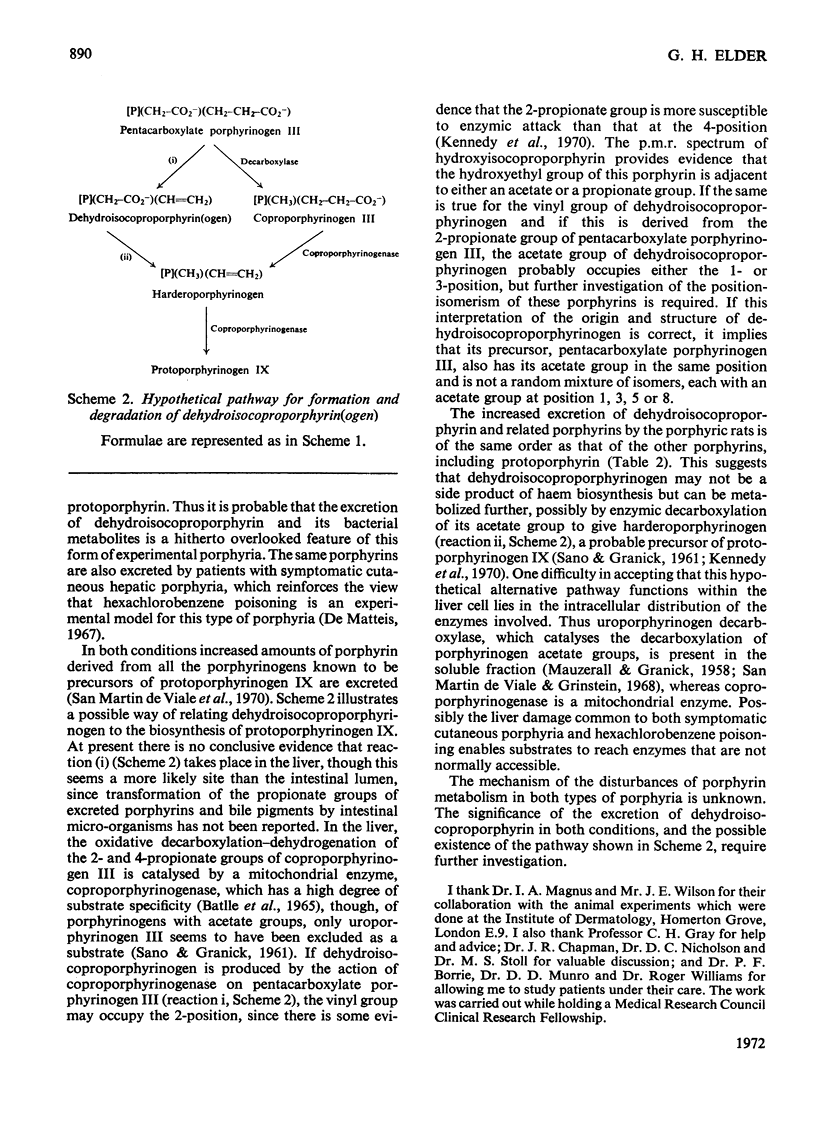
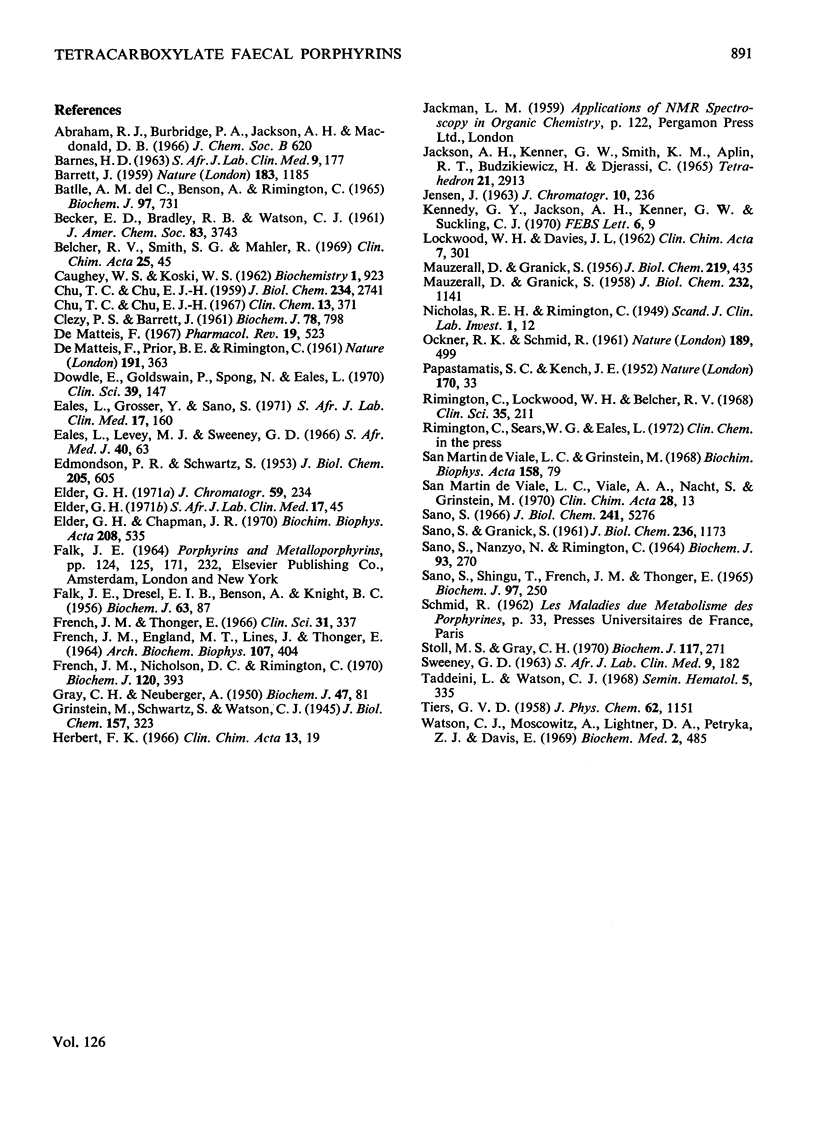
Selected References
These references are in PubMed. This may not be the complete list of references from this article.
- BARNES H. D. COUNTER-CURRENT ANALYSIS OF ETHER-SOLUBLE STOOL PORPHYRINS. S Afr J Lab Clin Med. 1963 Dec;14:177–182. [PubMed] [Google Scholar]
- BARRETT J. Detection of hydroxyl groups in porphyrins and chlorins. Nature. 1959 Apr 25;183(4669):1185–1186. doi: 10.1038/1831185a0. [DOI] [PubMed] [Google Scholar]
- Belcher R. V., Smith S. G., Mahler R. Biliary protein-bound porphyrins in porphyria variegata. Clin Chim Acta. 1969 Jul;25(1):45–52. doi: 10.1016/0009-8981(69)90225-3. [DOI] [PubMed] [Google Scholar]
- CAUGHEY W. S., KOSKI W. S. Nuclear magnetic resonance spectra of porphyrins. Biochemistry. 1962 Sep;1:923–931. doi: 10.1021/bi00911a028. [DOI] [PubMed] [Google Scholar]
- CHU T. C., CHU E. J. Hepta-, hexa-, and pentacarboxylic porphyrins of porphyria cutanea tarda. I. Isolation and properties of the porphyrins. J Biol Chem. 1959 Oct;234:2741–2746. [PubMed] [Google Scholar]
- CLEZY P. S., BARRETT J. The prosthetic group of cytochrome oxidase. 2. Chemistry of porphyrin alpha. Biochem J. 1961 Apr;78:798–806. doi: 10.1042/bj0780798. [DOI] [PMC free article] [PubMed] [Google Scholar]
- Chu T. C., Chu E. J. Porphyrin patterns in different types of porphyria. Clin Chem. 1967 May;13(5):371–387. [PubMed] [Google Scholar]
- DE MATTEIS F., PRIOR B. E., RIMINGTON C. Nervous and biochemical disturbances following hexachlorobenzene intoxication. Nature. 1961 Jul 22;191:363–366. doi: 10.1038/191363a0. [DOI] [PubMed] [Google Scholar]
- Dowdle E., Goldswain P., Spong N., Eales L. The pattern of porphyrin isomer accumulation and excretion in symptomatic porphyria. Clin Sci. 1970 Aug;39(2):147–158. doi: 10.1042/cs0390147. [DOI] [PubMed] [Google Scholar]
- EDMONDSON P. R., SCHWARTZ S. Studies of the uroporphyrins. III. An improved method for the decarboxylation of uroporphyrin. J Biol Chem. 1953 Dec;205(2):605–609. [PubMed] [Google Scholar]
- Elder G. H., Chapman J. R. Isolation of an hydroxylated porphyrin from urine and faeces of patients with cutaneous hepatic porphyria. Biochim Biophys Acta. 1970 Jun;208(3):535–537. doi: 10.1016/0304-4165(70)90229-1. [DOI] [PubMed] [Google Scholar]
- Elder G. H. Separation of porphyrin methyl esters by two-dimensional thin-layer chromatography. J Chromatogr. 1971 Jul 8;59(1):234–236. doi: 10.1016/s0021-9673(01)80037-6. [DOI] [PubMed] [Google Scholar]
- FALK J. E., DRESEL E. I., BENSON A., KNIGHT B. C. Studies on the biosynthesis of blood pigments. 4. The nature of the porphyrins formed on incubation of chicken erythrocyte preparations with glycine, delta-aminolaevulic acid or porphobilinogen. Biochem J. 1956 May;63(1):87–94. doi: 10.1042/bj0630087. [DOI] [PMC free article] [PubMed] [Google Scholar]
- FRENCH J. M., ENGLAND M. T., LINES J., THONGER E. SEPARATION OF ETHER-EXTRACTABLE FECAL PORPHYRINS BY COUNTER-CURRENT DISTRIBUTION. Arch Biochem Biophys. 1964 Sep;107:404–418. doi: 10.1016/0003-9861(64)90296-6. [DOI] [PubMed] [Google Scholar]
- French J. M., Thonger E. Ether-soluble porphyrins in bile, meconium and urine: a new appraisal by microscale counter-current analysis. Clin Sci. 1966 Dec;31(3):337–351. [PubMed] [Google Scholar]
- French J., Nicholson D. C., Rimington C. Identification of the acrylate porphyrin S-411 from meconium. Biochem J. 1970 Nov;120(2):393–397. doi: 10.1042/bj1200393. [DOI] [PMC free article] [PubMed] [Google Scholar]
- GRAY C. H., NEUBERGER A. Studies in congenital porphyria. I. Incorporation of 15N into coproporphyrin, uroporphyrin and hippuric acid. Biochem J. 1950 Jun-Jul;47(1):81–87. doi: 10.1042/bj0470081. [DOI] [PMC free article] [PubMed] [Google Scholar]
- Herbert F. K. Porphyrins excreted in various types of porphyria (with special reference to "pseudouroporphyrin"). Clin Chim Acta. 1966 Jan;13(1):19–30. doi: 10.1016/0009-8981(66)90260-9. [DOI] [PubMed] [Google Scholar]
- JENSEN J. Separation of the coproporphyrin isomers I and III by thin layer chromatography. J Chromatogr. 1963 Feb;10:236–238. doi: 10.1016/s0021-9673(01)92298-8. [DOI] [PubMed] [Google Scholar]
- Kennedy G. Y., Jackson A. H., Kenner G. W., Suckling C. J. Isolation, structure and synthesis of a tricarboxylic porphyrin from the harderian glands of the rat. FEBS Lett. 1970 Jan 15;6(1):9–12. doi: 10.1016/0014-5793(70)80027-8. [DOI] [PubMed] [Google Scholar]
- LOCKWOOD W. H., DAVIES J. L. Paper electrophoresis of urinary porphyrins. Clin Chim Acta. 1962 May;7:301–308. doi: 10.1016/0009-8981(62)90028-1. [DOI] [PubMed] [Google Scholar]
- MAUZERALL D., GRANICK S. Porphyrin biosynthesis in erythrocytes. III. Uroporphyrinogen and its decarboxylase. J Biol Chem. 1958 Jun;232(2):1141–1162. [PubMed] [Google Scholar]
- MAUZERALL D., GRANICK S. The occurrence and determination of delta-amino-levulinic acid and porphobilinogen in urine. J Biol Chem. 1956 Mar;219(1):435–446. [PubMed] [Google Scholar]
- OCKNER R. K., SCHMID R. Acquired porphyria in man and rat due to hexachlorobenzene intoxication. Nature. 1961 Feb 11;189:499–499. doi: 10.1038/189499a0. [DOI] [PubMed] [Google Scholar]
- PAPASTAMATICS S. C., KENCH J. E. Ionophoretic separation of porphyrin pigments. Nature. 1952 Jul 5;170(4314):33–34. doi: 10.1038/170033a0. [DOI] [PubMed] [Google Scholar]
- Rimington C., Lockwood W. H., Belcher R. V. The excretion of porphyrin-peptide conjugates in porphyria variegata. Clin Sci. 1968 Oct;35(2):211–247. [PubMed] [Google Scholar]
- SANO S., GRANICK S. Mitochondrial coproporphyrinogen oxidase and protoporphyrin formation. J Biol Chem. 1961 Apr;236:1173–1180. [PubMed] [Google Scholar]
- SWEENEY G. D. PATTERNS OF PORPHYRIN EXCRETION IN SOUTH AFRICA PORPHYRIC PATIENTS. S Afr J Lab Clin Med. 1963 Dec;14:182–190. [PubMed] [Google Scholar]
- San Martin de Viale L. C., Viale A. A., Nacht S., Grinstein M. Experimental porphyria induced in rats by hexachlorobenzene. A study of the porphyrins excreted by urine. Clin Chim Acta. 1970 Apr;28(1):13–23. doi: 10.1016/0009-8981(70)90155-5. [DOI] [PubMed] [Google Scholar]
- Sano S. 2,4-Bis-(beta-hydroxypropionic acid) deuteroporphyrinogen IX, a possible intermediate between coproporphyrinogen 3 and protoporphyrin IX. J Biol Chem. 1966 Nov 25;241(22):5276–5283. [PubMed] [Google Scholar]
- Sano S., Nanzyo N., Rimington C. Synthesis of porphyrin c-type compounds from protoporphyrinogen. Biochem J. 1964 Nov;93(2):270–280. doi: 10.1042/bj0930270. [DOI] [PMC free article] [PubMed] [Google Scholar]
- Sano S., Shingu T. The chemical structure of pemptoporphyrin. Biochem J. 1965 Oct;97(1):250–256. doi: 10.1042/bj0970250. [DOI] [PMC free article] [PubMed] [Google Scholar]
- Stoll M. S., Gray C. H. The oxidation products of crude mesobilirubinogen. Biochem J. 1970 Apr;117(2):271–290. doi: 10.1042/bj1170271. [DOI] [PMC free article] [PubMed] [Google Scholar]
- Taddeini L., Watson C. J. The clinical porphyrias. Semin Hematol. 1968 Oct;5(4):335–369. [PubMed] [Google Scholar]
- de Matteis F. Disturbances of liver porphyrin metabolism caused by drugs. Pharmacol Rev. 1967 Dec;19(4):523–557. [PubMed] [Google Scholar]
- del Batlle A. M., Benson A., Rimington C. Purification and properties of coproporphyrinogenase. Biochem J. 1965 Dec;97(3):731–740. doi: 10.1042/bj0970731. [DOI] [PMC free article] [PubMed] [Google Scholar]


